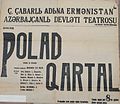I with bowl
 From Wikipedia the free encyclopedia
From Wikipedia the free encyclopedia
| I with bowl | |
|---|---|
| Ь ь | |
 | |
| Usage | |
| Writing system | Latin script |
| Type | Alphabetic |
| Language of origin | Yañalif |
| Sound values | [ɯ] [ɤ̆] [ɨ] |
| History | |
| Development |
|
| Other | |
| Writing direction | Left-to-Right |
Latin yeru[1][2] or I with bowl[3][dubious – discuss] (majuscule: Ь, minuscule: ь)[note 1] is an additional letter of the Latin alphabet based on the Cyrillic soft sign. It was introduced in 1928 into the reformed Yañalif, and later into other alphabets for Soviet minority languages. The letter was designed specifically to represent the non-front close vowel sounds ɨ and ɯ.[4] Thus, this letter corresponds to the letter ⟨I ı⟩ in modern Turkic alphabets,[5][6][7][8][9][10] and the letter yery (⟨Ы ы⟩) in Cyrillic.
Usage
[edit]The letter was originally included in the Yañalif and later also in the alphabets of the Kurdish, Abaza, Sami, Ingrian, Kalmyk, Komi, Tsakhur, Azerbaijani and Bashkir languages, as well as in the draft reform of the Udmurt alphabet. During the project for romanizing Russian, the letter corresponded to the Cyrillic letter ⟨Ы ы⟩. In Kalmyk, however, it represented palatalisation of the preceding consonant and thus corresponded to the Cyrillic homoglyph ⟨Ь ь⟩.
In languages and alphabets that used the letter, the lowercase form of B was a small capital ⟨ʙ⟩ so that there would be no confusion between ⟨b⟩ and ⟨ь⟩.
- New Turkic alphabet (Yañalif)
- The Latin-based Unified Northern Alphabet
- Kurdish alphabet of 1929
- Abazin alphabet of the 1930s
- Sami alphabet of 1933
- Komi alphabet of 1934
- Tsakhur alphabet of 1934
- The draft reform of the Udmurt and Komi scripts of 1931
- Crimean Tatar alphabet from the 1920s, with the Latin script in the middle columns.
- Table of contents, on a book, showing the use of Ь in some words.
- Tour poster showing the promo of a state conservery, I with bowl can be seen.
- Comparison of the New Turkic alphabets, as well as examples of sentences.
- Book cover, whose title translates to "On Surkhan," shows the use of the letter in the word "Bujьnda."
- Wall sign at a ballet theatre, notice the I with bowl is barely visible at the top of it.
- Sample ballot in Crimean Tatar for voting elections to the Supreme Soviet of the Crimean ASSR in 1938.
- Examples of sentences in Latin-script Komi.
- Janjur Saman theatrical play poster
- Yerevan State poster for the opera show at an Azerbaijani theatre.
- Front title on an Azerbaijani book, whose title translates roughly to "Lovers."
- Poster of Leyli and Majnun, with Latin-script on top section.
- 1936 bulletin about Baku theatres.
- Emblem of Azerbaijani SSR from 1937-1940. I with bowl is found in the words "Respuʙliqasь" and "Proletarlarь."
- Azerbaijani dance melody sheet. The letter can be seen in the title written in Latin script.
Encoding
[edit]A Latin letter I with bowl has not been adopted into Unicode because of the concern that encoding it could open the door to "duplicating the whole Cyrillic alphabet as Latin letters."[1][2][11][3] Instead, computer and mobile users can substitute similar letters: either Ь ь or Ƅ ƅ (Latin letter tone six, the letter that had been used in the Zhuang alphabet to denote the sixth tone IPA: [˧]).
See also
[edit]Notes
[edit]- ^ Here represented with the Cyrillic soft sign, to which it is homoglyphic
References
[edit]- ^ a b Karl Pentzlin, Ilya Yevlampiev (2008-11-03). "Proposal to encode four Latin letters for Jaꞑalif" (PDF). Retrieved 2017-10-24.
- ^ a b Karl Pentzlin, Ilya Yevlampiev (2010-09-24). "Proposal to encode two Latin letters for Jaꞑalif" (PDF). Retrieved 2017-09-28.
- ^ a b Nikita Manulov (2022-05-20). "Proposal to encode Latin capital and small letter I with bowl" (PDF). Retrieved 2022-06-28.
- ^ W. K. Matthews (2013). Languages of the USSR. Cambridge: Cambridge University Press. p. 71. ISBN 978-1-107-62355-2.
- ^ Tatar (tatarça / татарча / تاتارچا)
- ^ Azerbaijani (آذربايجانجا ديلي / Azərbaycan dili / Азәрбајҹан дили)
- ^ Karaim (къарай тили, Karay dili, לשון קדר)
- ^ Khakas (Хакас тілі / Khakas tîlî)
- ^ Kumyk (Къумукъ тил / Qumuq til)
- ^ Tuvan (Тыва дыл / Tyva dyl)
- ^ "Proposal to encode Latin letters used in the Former Soviet Union" (PDF). 2011-10-18. Retrieved 2017-09-26.





















